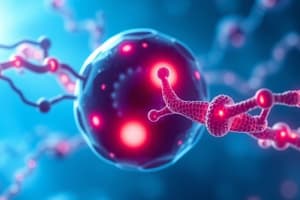Podcast
Questions and Answers
What defines Receptor Tyrosine Kinases (RTKs)?
What defines Receptor Tyrosine Kinases (RTKs)?
- Presence of serine kinase activity
- Presence of tyrosine kinase activity (correct)
- Presence of G protein activity
- Presence of lipid kinase activity
How do RTKs behave in their monomeric form?
How do RTKs behave in their monomeric form?
- They contain multiple subunits
- They are inactive (correct)
- They exist as dimers of two hemireceptors
- They dimerize upon ligand binding
What happens to RTKs when they bind one ligand molecule?
What happens to RTKs when they bind one ligand molecule?
- They dissociate
- They heterodimerize with closely related receptors
- They dimerize (correct)
- They remain monomeric
Which receptors are an exception to the typical dimerization pattern of RTKs?
Which receptors are an exception to the typical dimerization pattern of RTKs?
What binds to the N-terminal extracellular ligand binding domains of RTKs?
What binds to the N-terminal extracellular ligand binding domains of RTKs?
How many receptor tyrosine kinases are encoded in the human genome?
How many receptor tyrosine kinases are encoded in the human genome?
What distinguishes the carboxy terminals of RTKs like insulin/IGF-1 receptors and FGFR from others?
What distinguishes the carboxy terminals of RTKs like insulin/IGF-1 receptors and FGFR from others?
What is a characteristic feature of the nuclear receptors?
What is a characteristic feature of the nuclear receptors?
How do receptors for cortisol and aldosterone behave prior to ligand binding?
How do receptors for cortisol and aldosterone behave prior to ligand binding?
What is the function of the N-terminal sequence in nuclear receptors?
What is the function of the N-terminal sequence in nuclear receptors?
How are the receptors for thyroid hormone and 1α,25(OH)2-vitamin D3 typically found in target cells?
How are the receptors for thyroid hormone and 1α,25(OH)2-vitamin D3 typically found in target cells?
What distinguishes about half of the nuclear receptors according to the text?
What distinguishes about half of the nuclear receptors according to the text?
Flashcards are hidden until you start studying




